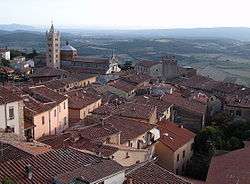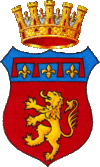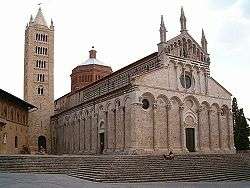Massa Marittima
| Massa Marittima | ||
|---|---|---|
| Comune | ||
| Comune di Massa Marittima | ||
 | ||
| ||
 Massa Marittima Location of Massa Marittima in Italy | ||
| Coordinates: IT 43°03′00″N 10°53′37″E / 43.05000°N 10.89361°ECoordinates: IT 43°03′00″N 10°53′37″E / 43.05000°N 10.89361°E | ||
| Country | Italy | |
| Region | Tuscany | |
| Province / Metropolitan city | Grosseto (GR) | |
| Frazioni | Ghirlanda, Niccioleta, Prata, Tatti, Valpiana | |
| Government | ||
| • Mayor | Marcello Giuntini | |
| Area | ||
| • Total | 283.73 km2 (109.55 sq mi) | |
| Elevation | 380 m (1,250 ft) | |
| Population (31 December 2014) | ||
| • Total | 8,483 | |
| • Density | 30/km2 (77/sq mi) | |
| Demonym(s) | Massetani | |
| Time zone | CET (UTC+1) | |
| • Summer (DST) | CEST (UTC+2) | |
| Postal code | 58024 | |
| Dialing code | 0566 | |
| Patron saint | Saint Cerbonius | |
| Saint day | October 10 | |
| Website | Official website | |
Massa Marittima is a town and comune of the province of Grosseto, southern Tuscany, Italy, 49 km NNW of Grosseto.
There are mineral springs, mines of iron, mercury, lignite and copper, with foundries, ironworks and olive-oil mills. At Follonica, on the coast, are the furnaces in which are smelted the iron ore of Elba.
History
The town appeared in the early Middle Ages, the bishopric seat of Populonia being moved here around 1000 AD. After the initial domination of the Republic of Pisa, it became an independent commune in the 13th century.
In the following century it was conquered by Siena, to which it belonged until it became part of the Grand Duchy of Tuscany in the mid-16th century.
Main sights
- The 13th century Saint Cerbonius Cathedral (13th century). The church is in Romanesque-Pisane style, and is on the Latin cross plan, with a nave and two aisles divided by cruciform pilasters and cylindrical columns. The central portal has lion sculptures and five panels with stories of Saint Cerbonius, to whom the cathedral is dedicated. The rose window has a rare 14th century glass with the Redeemer in Glory and Histories of St. Cerbonius. The interior is home to a Romanesque font (1267 with a cover of 1447), a Gothic reliquary (1324) of Saint Cerbonius, a Maestà attributed to Duccio di Buoninsegna (1316) and 14th-century fresco under which is a Roman sarcophagus from the 4th century AD.
- The battlemented Palazzo Pretorio. It houses the Archaeological Museum, containing a work by Ambrogio Lorenzetti.
- The Cassero Senese (Sienese Fortress), built in the 13th–14th centuries.
- Monteregio Castle, built by the Aldobrandeschi in the 9th century, later used as the bishops' residence.
- Church of St. Francis, founded, according to the tradition, by the saint himself in Gothic style. It houses an Assumption by Raffaello Vanni.
- Fonti dell'Abbondanza, of the 13th century, the end point of a water supply project. This palazzo features a unique fresco of a phallus tree, dubbed The Fertility Tree after its discovery in 2000.[1]
- Church of St. Augustine (14th century), with a Renaissance cloister.
- Palazzo del Podestà.
- Palazzo delle Armi, in Renaissance style.
- Church of San Rocco (15th century).
- Native house of San Bernardino da Siena.
In the frazione of Prata are a medieval castle with two towers and the Pieve of Santa Maria Assunta. The walled borough ot Tatti includes the medieval church of San Sebastiano and another Cassero.
People
Massa Marittima is possibly the birthplace of the fourth-century emperor Constantius Gallus.[2]
St. Bernardino da Siena was born here in 1380.
References
- ↑ Stiles, Donna. "Art in The Middle Ages: Unrivaled Medieval Art". Maremma Guide. Retrieved 2013-06-23.
- ↑ Smith, William (1854). "Massa". Dictionary of Greek and Roman Geography. Perseus Digital Library.
 This article incorporates text from a publication now in the public domain: Chisholm, Hugh, ed. (1911). "article name needed". Encyclopædia Britannica (11th ed.). Cambridge University Press.
This article incorporates text from a publication now in the public domain: Chisholm, Hugh, ed. (1911). "article name needed". Encyclopædia Britannica (11th ed.). Cambridge University Press.
External links
| Wikimedia Commons has media related to Massa Marittima. |
- Massa Marittima - Maremma Tuscany : Travel Guide and Vacation Accommodations
- Massa Marittima in Winter
- Walking in Massa Marittima
- Massa Marittima art pictures
- From Fertility Symbol to Political Propaganda – Decoding the Massa Marittima Mural.

